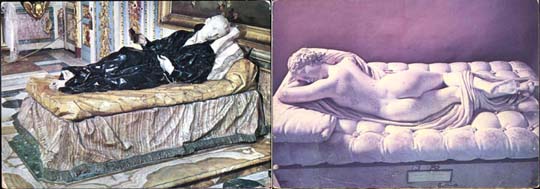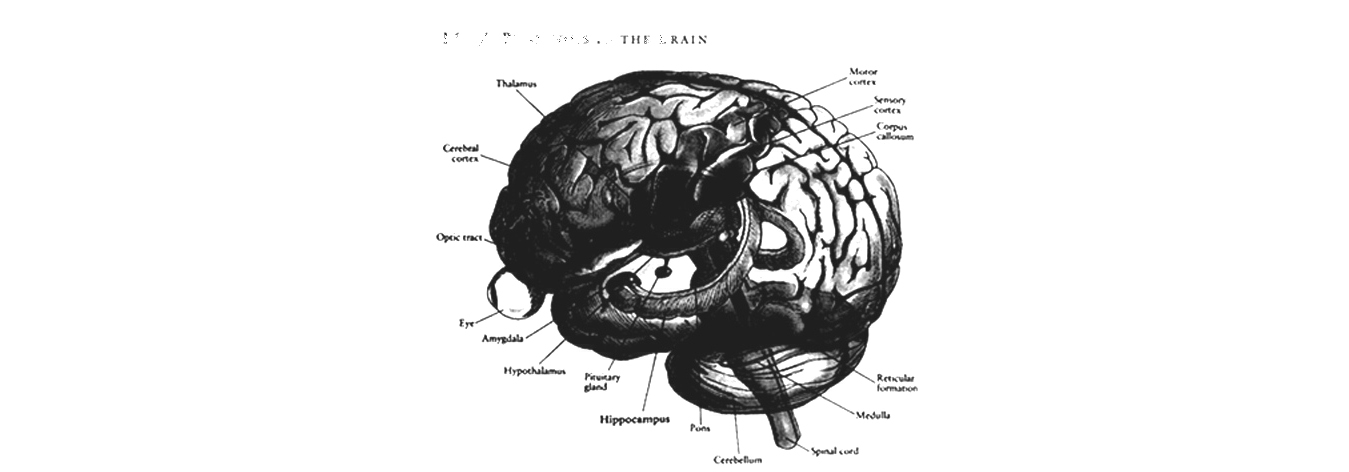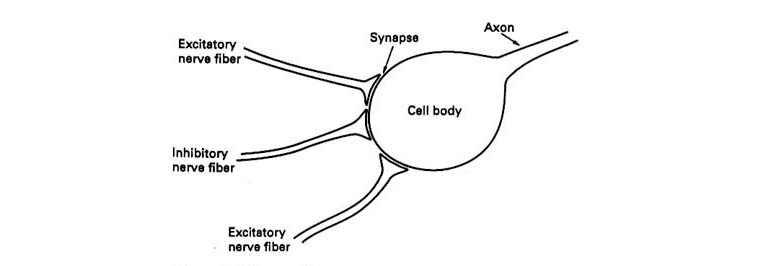In 1892, Charles Darwin categorized human affects into seven or eight discrete expressions, each with its own facial display: happiness, sadness, fear, anger, disgust, surprise, interest, perhaps shame, and their combination. (The Expression of the Emotions in Man and Animals) According to Darwin, "The same state of mind is expressed throughout the world with remarkable uniformity." He postulated that these innate patterns of feeling and facial display evolved as social signals "understood" by all members to enhance species survival. (cf ritualization ) For Darwin, our expressions of emotion are universal (that is, innate not learned) and they are products of our evolution. They are also, at least to some extent, involuntary, and feigned emotions are rarely fully convincing.
mind / brain / emotion
agency
anosognosia
The tendency to ignore or sometimes even to deny that one's left arm or leg is paralyzed was termed anosognosia, ("unaware of illness") by the French neurologist Francois Babinski, who first observed it clinically in 1908. In anosognosia, the patient is unaware of or denies a paralyzed limb, and in hemianosognosia, the patient behaves as if half the body were nonexistent. The "counterfeit" limb is a milder version of anosognosia, where the limb seems less than real. Oliver Sachs describes how his paralyzed leg had "vanished, taking its place with it...The leg had vanished taking its 'past' away with it. I could no longer remember having a leg." (See Oliver Sachs, A Leg to Stand On, New York, 1984,)
Read Moreanxiety
For Kurt Goldstein, anxiety has no "object," and is qualitatively different from fear. In fact, for Goldstein, fear is the anticipation of anxiety. For Kierkegaard and Heidegger, anxiety deals with "nothingness." It is a breakdown of both world and self. For Goldstein, the drive to overcome anxiety by the conquest of a piece of the world is expressed in the tendency towards order, norms, continuity, and homogeneity. Deleuze and Guattari echo this diagnosis when they claim that striation is negatively motivated by anxiety in the face of all that passes, flows, or varies and erects the constancy and eternity of an in-itelf.
Read Moreattention
Attention, according to William James, is "the taking possession by the mind, in clear and vivid form, of one out of what may seem several simultaneously possible objects or trains of thought." Any model of attention must account for its selectivity, for the fact that, after an animal learns a skill, it becomes automatic (or unconscious), for the ability to interrupt automatic acts by attention to novelty, and for the ability to direct attention specifically by conscious means. (Edelman)
Read MoreAutopoesis
Autopoesis is both a concept about self-maintaining systems, especially biological ones, and an epistemological theory about cognition and self-reference.
Read MoreHanna Wilke from IntraVenus
body image
Two English neurologists, Lord Russell Brain and Henry Head (!) coined the phrase "body image" for the internal image and memory of one's body in space and time. The body-image mediates the mind / body polarization. It requires input from both sides to be effective.
Read Morebody thinking
In Antiquity, Body and Mind were not yet explicitly viewed as separate entities. This is reflected by the fact that the Greek word soma in Homeric verses referred to a corpse, not a living body. Neither the living body as an entity nor the Mind as an entity had a name. (see Bruno Snell, The Discovery of the Mind in Greek Philosophy and Literature.) But For Aristotle, thinking is the one specific activity of the human soul which is capable of separate and independent existence from any connection to the body.
In Love's Body, Norman O. Brown proposes an alternative to the dualism, established by the reality principle, between inside and outside, between the Lockean and Cartesian notions of mental events as distinct from external, material reality. He rejects the " simple location" of the body as a thing which is here in space and here in time. (see p. 154. see also ego and play)For Brown, the alternative to dualism is dialectics, that is to say, love.
body

Aristotle distinguished between the body and the soul. The latter referred not only to the principle of life, but to the form of a particular living body. Thus the soul is the organization of the body. (cf. organism) Aristotle rejected the doctrine of the Pythogoreans, according to which the soul can clothe itself in different bodies. (see clothing/garment ) Instead, a particular soul is the entelechy, or formative force of a particular body, and the individuality of a particular man. Thus every particular soul requires a connection to a particular organic whole. At the same time, he upheld a division between matter and form which describes, for example, the relation between the eye and sight. When the power of sight is absent, the eye is no longer an eye in the proper sense. After taking the position that "..there seems to be no case in which the soul can act or be acted on without involving the body," Aristotle goes on to suggest that thinking is the one specific activity of the human soul which is capable of separate and independent existence from any connection to the body. (see also subject )
brain

How do mental functions map on to the brain? During the 1940's and 1950's, the brilliant Canadian neurosurgeon Wilder Penfield performed extensive brain surgeries on patients with local anaesthetic. During the operations, he stimulated specific regions of the patients' brains with an electrode and simply asked them what they felt. All kinds of sensations, images, and even memories were elicited by the electrode, and the somatosensory areas of the brain that were responsible could be mapped. Penfield concluded that memories left permanent imprints on the brain. (also called engrams) Among other things, Penfield found a narrow strip running from top to bottom down both sides of the brain where his electrode produced sensations localized in various parts of the body. This "sensory homunculus," as it is now called, forms a greatly distorted representation of the body on the surface of the brain, with the parts that are particularly important taking up disproportionately large parts. (see image below) (see also body image ) For the most part, the map is orderly but upside down. However, the map is not entirely continuous.
Read Moreconsciousness
"Consciousness. The having of perceptions, thoughts, and feelings; awareness....When asked what consciousness is, we have no better answer than Louis Armstrong's when a reporter asked him what jazz is: "Lady, if you have to ask, you'll never know." (quoted in Pinker, How the Mind Works, p.60)
Read Moredesire
Freud's use of the word Wunsch, which corresponds to 'wish' does not have the same connotations as the English word 'desire" or the French désir . His clearest elucidation of the concept is in the theory of dreams. Freud does not identify need with desire. Need can be satisfied through the action which procures the adequate object. (eg. food) Wishes, on the other hand, are governed by a relationship with signs, with memory-traces of excitation, and the desire to re-cathect mnemic images. The Freudian conception of desire refers above all to unconscious wishes, bound to indestructible infantile signs, organized as phantasy.
Read Moreempathy
In the late nineteenth century, the concept of Einfühlung , as "feeling into," was proposed by Rudolph Lotz and Wilhelm Wundt. E. G. Tichener, a student of Wundt, coined the English translation "empathy" in 1910, using the Greek root pathos for feeling and the prefix em for in. Empathy was developed as an aesthetic theory in the work of Theodore Lipps and others.
Read Moreeroticism
Georges Bataille defines eroticism as the "assenting to life up to the point of death". (Erotism, introduction) For Bataille, eroticism distinguishes man from the animals because it is a consciously intellectualized feeling that is possible only in a context where sexuality is repressed, or at least where erotic pleasure is independent of reproduction as an end. Bataille relates eroticism to a knowledge of evil and the inevitability of death, rather than simply an expression of joyful passion. He quotes de Sade's observation that "There is no better way to know death than to link it with some licentious image." While De Sade's "aberration" may be the logical extreme of this link, "In essence, the domain of eroticism is the domain of violence, of violation." (p. 16)
Read Moreforgetting
Are all memoriespermanently stored somewhere in the mind, so that details we cannot remember at a particular time could eventually be recovered with the right technique? Or are some experiences permanently lost from memory?
Read Morehaptic/optic
In contrast to the optic, the haptic sense, or sense of touch, has a "closeness" and immediacy which seems to escape technological mediation and evokes a more interior sense. The sense of touch is usually subordinated to the visual, which is identified with the conceiving mind over the perceiving body. (cf. also proprioceptive)
Read Moreinstinct
Instinct, for both psychology and ethology is a preformed behavioral pattern, often manifesting itself immediately from birth. Its arrangement is determined hereditarily and is repeated according to modalities relatively adapted to a certain kind of object. (from Laplanche, Life and Death in Psychoanalysis) Instinctive behaviour contributes to the survival of species and is evolved like morphological structure. (Bowlby) Charles Darwin outlined the modern theory of instinct in The Origin of Species.
Read Moremind / brain
How does the physical brain give rise to the psychological mind? How do the laws of mental life emerge from the brain?
The hypothesis of all those who examine the brain as "organ of the mind" is that a close enough analysis of the workings of the brain would, if we also had the key to psychophysiology, lead to a knowledge of consciousness. The psychophysiological hypothesis, at least in its narrow version of it, seeks point-to-point mappings of brain, consciousness, and memory.
neuron

Neurons are rather different from most cells. Mature neurons do not move about, nor do they divide. If a mature neuron dies, it is rarely replaced by a new one. Neurons have a more spikey shape than most cells, and the axon of a neuron can be very long -- as much as several feet. Neuroscientists today believe that the brain records an event by strengthening the connections between groups of neurons that participate in encoding the experience. (see engram)
Read Morepack donkey/man
"Man walks in a straight line because he has a goal and knows where he is going; he has made up his mind to reach some particular place and goes straight to it.The pack-donkey meanders along, meditates a little in his scatter-brained and distracted fashion, he zigzags in order to avoid the larger stones, or to ease the climb, or to gain a little shade; he takes the line of least resistance.
Read More
